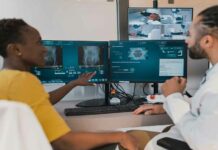GE Healthcare (NYSE: GE) and Royal Philips Electronics applaud the Federal Communications Commission (FCC) today for its action allocating protected spectrum for wireless medical devices, called Medical Body Area Networks (MBANs), which could revolutionize the way patients are monitored and help eliminate the restrictive cables that tether patients to hospital beds. MBANs—small, wearable wireless sensors that capture patient vital signs—could help extend care anywhere throughout the hospital or even remotely in the home. By providing access to spectrum that is free of transmissions from WiFi and other ubiquitous high-powered consumer devices, the FCC’s ruling is a key enabler for MBANs.
Today, nearly all patient monitors are connected to patients via cables. By eliminating these wires, MBANs could help patients be more mobile, which may contribute to improved patient outcomes and recovery, and enhance their overall comfort. Small, wearable sensors could collect real-time clinical information such as temperature and respiratory function, and aggregate it at a nearby device for local processing and forwarding to centralized displays and electronic medical records.
“MBANs represent the next evolution in monitoring a patient’s health status,” said Dr. Richard Katz, Director, Division of Cardiology, Bloedorn Professor of Medicine, The George Washington University Hospital. “These wireless innovations can enhance patient safety by giving caregivers the ability to monitor many clinical measurements, wherever the patient is located.”
MBANs could offer the following, additional benefits in the hospital:
Early intervention: Clinicians can catch issues before the patient’s condition becomes critical, thus improving patient outcomes while avoiding the need for acute interventional measures.
Ease of patient transport: There will no longer be a need to disconnect and reconnect wires prior to transporting a patient.
Infection control: By limiting the wires, MBANs could help reduce the risk of infection and the need for cleaning procedures.
Flexibility: Caregivers will be able to quickly add or remove sensors for different physiological parameters as medical conditions warrant.
In the current healthcare system, patients are primarily monitored in acute and critical-care departments. MBANs are low-cost wearable sensors that could allow clinicians to view vital signs for a patient wherever they are—from hospitals to emergency vehicles to the home.

















